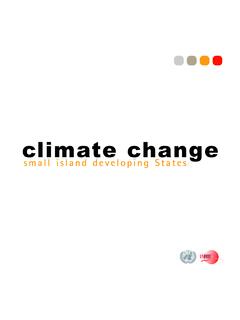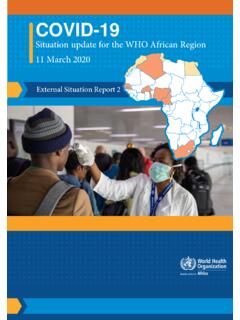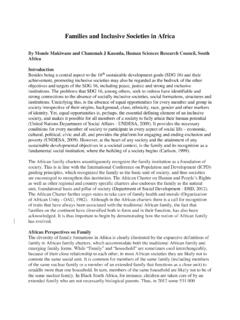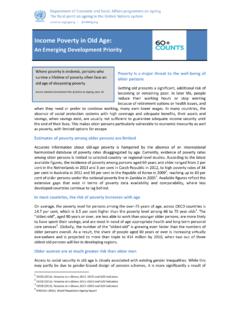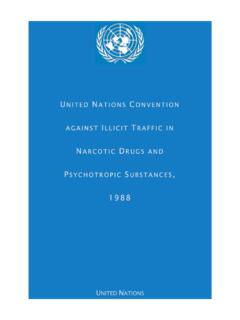Transcription of Global Overview Status of Polio Eradication
1 Global Overview Status of Polio Eradication2021 Annual Session of the UNICEF ExecutiveBoard 1 to 4 June 2021 INFORMATION NOTE FOR THE SPECIAL FOCUS SESSION ON POLIOA bbreviations 2nOPVnovel oral poliovaccinenOPV2novel oral Polio vaccine type2 for vaccination against circulating vaccine derived Polio virus type 2 OPVoral Polio vaccineSAGES trategic Advisory Group of Experts on ImmunizationSIAsupplementary immunizationactivitiestOPVtrivalent oral Polio vaccine (used against Polio virus type 1, 2 and 3)WPVwild Polio virusWPV1wild Polio virus type 1 WPV2wild Polio virus type 2 WPV3wild Polio virus type 3 AFPacute flaccidparalysis (cases of paralysis detected in children caused by the Polio virus) bOPVbivalent oral poliovaccine (used against Polio virus type 1 and type 3)CDCC enters for Disease Controland Prevention ( united states )
2 CVDPV circulating vaccine-derived Polio virus cVDPV1circulating vaccine-derivedpolio virus type 1cVDPV2circulating vaccine-derivedpolio virus type 2cVDPV3circulating vaccine-derivedpolio virus type 3 GPEIG lobal Polio Eradication InitiativeIMBI ndependent Monitoring BoardIPVinactivated poliovaccinemOPV2monovalent oral Polio vaccine (used against Polio virus type 2)Key Polio milestones Polio cases reduced by per cent between 1988 and out of three* types of wild Polio virus have been region certified wild Polio free in August 2020.* There are three types of wild Polio virus: wild Polio virus type 1 (WPV1); wild Polio virus type 2 (WPV2) and wild Polio virus type 3 (WPV3).
3 WPV2 was eradicated in 2015 and WPV3 in 2019. Click here for more paralysed by Polio : 2018 2021 (as at 5 May 2021)WHO data as at5 May 202133175140050100150200201820192020 Wild Polio virus (WPV)Number of confirmed WPV cases in 2020 & 2021 in the same time period (1 Jan 5 May)20202021 Afghanistan51 Pakistan 411 Total4621053641,085750200400600800100012 002018201920202021 Circulating vaccine-derived Polio virus (cVDPV)(As of May 5, 2021)Number of confirmed cVDPV cases in 2020 & 2021 (1 Jan 5 May)20202021cVDPV type112cVDPV type 210073 Total10175 Endemic country (WPV1)Wild Polio virus (WPV1)cVDPV type 1cVDPV type 2 This map does not reflect a position by UNICEF on the legal Status of any country or territory, or the delimitation of any is circulating-vaccine derived Polio virus?
4 Circulating vaccine-derived Polio virus (cVDPV) could emerge if the weakened live virus contained in oral Polio vaccine (OPV), shed by vaccinated children, is allowed to circulate in under-immunized populations for long enough to genetically mutate to a form that causes paralysis. While one child with Polio is one too many, more than 10 billion doses of OPV have been given to nearly 3 billion children worldwide since the year 2000, and just over 2,299 cases ofcVDPV paralysis have been registered during that Insufficient routine immunization coverage due to weak health infrastructure in affected countries and Global vaccine supply constraints. Declining mucosal immunity levels to the type 2 virus among young children born after the switch from trivalent oral Polio vaccine to bivalent oral Polio vaccine.
5 Regional migration patterns leading to missed children in vaccination campaigns. Low-quality outbreak response campaigns. Risk of seeding new outbreaks through the use of mOPV2 in areas with low immunization coverage following the switch , which makes the need for a vaccine with increased genetic stability critical for do cVDPV2 outbreaks continue to occur?Low immunity to type 2 cVDPVdue to:WHAT IS nOPV2?7nOPV2 Genome with modificationsMing Te Yeh, Erika Bujaki, Patrick T. Dolan, Matthew Smith, Rahnuma Wahid, John Konz, Amy J. Weiner, Ananda S. Bandyopadhyay, Pierre Van Damme, Ilse De Coster, Hilde Revets Andrew Macadam, and Raul Andino, Engineering the Live-Attenuated Polio Vaccineto Prevent Reversion to Virulence , Cell Host and Microbe, : A new toolto stop cVDPV2 outbreaks nOPV2 is a modified version of mOPV2.
6 Like mOPV2, it will be used in outbreak response Studies to date have shown that nOPV2 is more genetically stable and therefore less likely to revert to a form that can cause paralysisSeveral countries began rolling out nOPV2 in late March 2021 under emergency use listing thanks to the support, commitment and leadership of the Bill & Melinda Gates Foundation in particular, in addition to partners of the Global Polio Eradication readiness updateDiscussionsongoing(14)Preparations launched(2)Verificationinprogress(22)Ver ified(5)27 countries across three regions have submitted documents in support of their readiness to introduce nOPV2: africa (22 countries) Europe (1 country) Middle East (4 countries)5 countries have been verified as ready to use nOPV2: Benin Liberia Nigeria Sierra Leone TajikistanThis map does not reflect a position by UNICEF on the legal Status ofany country or territory or the delimitation of any two countries to roll out nOPV2 CountryVaccination campaign date Target population (Children aged 0 to 59 months)Nigeria (Delta, FCT, Sokoto, Zamfara, Niger, Bayelsa staet)Round 1 (R1): COMPLETEDR ound 2 (R2): Ongoing7,208,970 LiberiaR1: COMPLETEDR2.
7 28-31 May 2021938,000nOPV2 roll out has begunCURRENTLY PLANNED nOPV2 responses*CountryPlanned campaign dates Target population (Children aged 0 to 59 months)BeninR1: COMPLETED1,805,538 Sierra LeoneLast Week of May 20211,472,813 Nigeria (Kebbestate)Last Week of May 20211,688,246 TajikistanLast week of May 20211,271,566 *Campaign dates are dependent on national contexts ( , elections, other vaccine-preventable disease emergencies/campaigns), as well as COVID-19 situations in-country along with COVAX vaccine progress towards Eradication has triggered a strategy revision to address the strategic and emergent ensure a comprehensive understanding of challenges and potential solutions, the GPEI engaged with over 300+ stakeholders for an extensive and inclusive strategy development process that included.
8 GPEI partner agencies& Strategic Committee35-member external stakeholder panelStaff from 10 major donors5 nationalGovernmentsThe GPEI Polio Endgame Strategy 2019-2023 did not adequately address:COVID-19 Emergency posturenOPV2 introductionCollective engagementStrategic elementsFinancial environmentGPEI structureNon-Epidemiologicalgaps/needsEm ergent considerationsTechnical advisers(IMB*, SAGE**)75 GPEI country & field team staffGPEI Strategy 2022 2026*Independent Monitoring Board **Strategic Advisory Group of Experts on ImmunizationThe resulting strategy seeks to drive a shift in two key ways across both endemic and outbreak countriesEmergency focusIn this strategy, GPEI commits to: Re-establishing Polio Eradication as a public health emergencyand priority of the highest order.
9 Holding the partner Governments, agencies and others who support the strategy accountablefor rapid progress, as a means of cementing the emergency nature of the engagement In this strategy, GPEI commits to: Betterreflect the needs, voices, and capabilities of the broad spectrum of stakeholderson whom Eradication depends. Shift the balance of capacity and decision-making away from HQ-leveltowards regional and overarching strategic shifts reflect the collective will of the six partner agencies (including country and regional staff), donors, governments and external experts engaged throughout the GPEI most extensive strategy process to-dateThe strategy aims to achieve the vision of eradicating Polio and sustaining a Polio -free worldTwo goalswill deliver on the vision of a Polio -free worldFive strategic objectivesprovide the means by which to achieve Goals 1 and 2 Seven enabling factors are critical to the success of the strategic objectivesGOAL 1.
10 Permanently interrupt all poliovirus transmission in the endemic countries Lack of ACCESSto areas controlled by anti-government elements in Afghanistan, resulting in million children missed by campaigns since 2018. Partnership with Pashto communities, which represent 15% of population but 85% of cases. Sub-optimal SIA performance, especially in key reservoir areas Government ownership, particularly at the sub-national level. Polio fatigue from Polio -only challengesStrategic objectivesPolitical advocacy -including moreproactiveandstrategicapproach to partnering withgovernmental stakeholdersfrom all levelsin Afghanistan and Pakistan tobuild trust andadvocate for Polio eradicationpriorities, listening and respondingto inputand concernsthrough two-way ongoing engagementto foster greater co-ownership and vaccine receptivity in focus populations, including evolvingthe composition.











